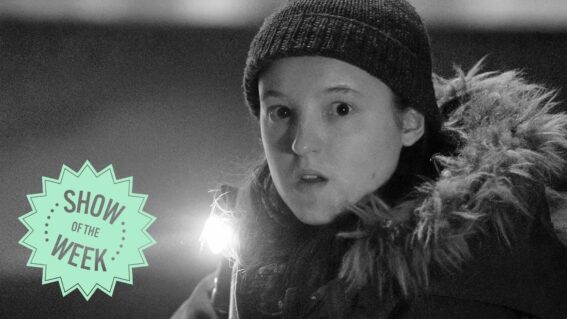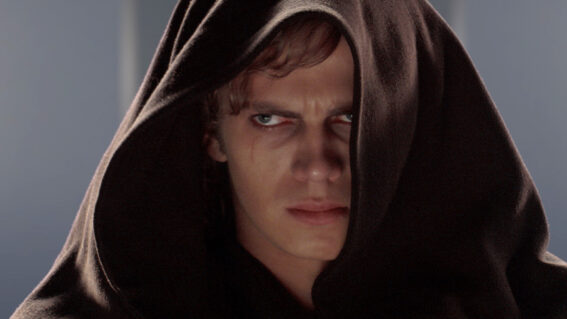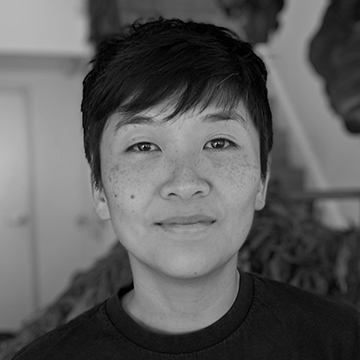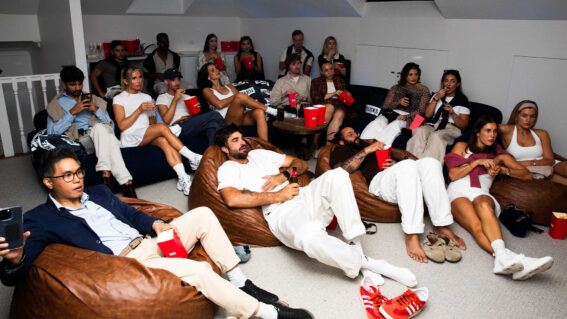Director Jeremy Saulnier takes us into his shocking Green Room

Join us backstage at Flicks as we revisit Steve Newall’s 2016 conversation with director Jeremy Saulnier about his spectacular punk rock thriller Green Room.
Jeremy Saulnier’s brutal Green Room is one of the movie highlights of the year, picking up comments like “tightly scripted, knuckle-whitening”, “expertly crafted”, and “a rare five-star survival thriller” from our writers. The late Anton Yelchin leads this tale of a punk band in the wrong place at the wrong time, going up against skinheads led by a chilling Patrick Stewart.
We stepped outside the comfort of our office and into a suitable location to chat with Saulnier about his simply awesome pic.
FLICKS: Hey, I’ll just set the scene. I’m sitting in my car, just parked around the corner from work. I’ve got quite a noisy office, but I’m sitting in what feels like quite a authentically punk scene 1993 Suzuki Swift hatchback.
JEREMY SAULNIER: Well, perfect.
It’s not a million miles away from what Ian MacKaye would drive. I think he’s got a Corolla, but it’s in the same ballpark… Is the DIY punk subculture something that you’ve inhabited or was it just something you gravitated towards?
No, I missed the total golden years, but I was in there early ’90s. So, it was a very vibrant time. The band I was in was actually recording a demo and Ian MacKaye walked into Inner Ear [chuckles]. It was that kind of world. We, of course, had to stop playing our song and just make sure he left the room before he heard us.

Not to knock your band, but I think that’s what anyone would do. What was the name of your band?
It’s a complicated name.
Go for it.
It’s sort of a little thing that backfired on us. It was called No Turn On Fred, because it was named after all the traffic signs. The no turn on red signs in our neighborhood had a decade-long history of vandalism. Most of the signs in our neighborhood were spray painted with an F in front of the red. It’s a very cheesy, basic, old school vandalism, but it was just sort of near and dear to us, and so we get 300 free postcards around town. But it was so esoteric and it made perfect sense within our small town. But when we took our band out and made it across the bridge to Washington DC, we ended up just having to go by the initials N-T-O-F in scary font and just kind of forgo the explanation [laughs].
Using that acronym leaves heaps to the imagination. It’s kind of like your films.
Yeah, exactly. Less is more.
You are, by the way, talking to someone whose band names included ‘Shithawks’ and ‘Sports’, so I’m kind of familiar with those bad decisions that can get made in the band room.
Well, those require no explanation. “Yeah, we’re the Shithawks” [laughs]
Exactly! Hey, I’ve seen ‘Green Room’ a couple times now and I really enjoyed both experiences.
Well, great.
I decided to sit in the back row in the second viewing and focus on the audience during key moments. Have you enjoyed doing that, seeing the way people react to it?
Yeah, for sure. This is such a compressed schedule for the movie. Actually, it was an old idea that I had floating around for years but the execution from page one of the script to wrapping production was one year.
Wow.
And then we went straight through to Cannes deadline. Had two weeks off, and then boom! right into post-production.We were sprinting the entire time. So, I was just so close to the material – almost too close – and was working on story and refining the choreography with the editor and action sequences and just really down to each frame. The sound makes it so important to the immersive quality of the film that I lost track of what the hell the movie was. So, my great joy was not even at Cannes, at Toronto I got to take a breath watching it with the Midnight Madness crew. Just seeing the audience, and that’s where I understood that we had pretty much achieved the objective. That’s how I enjoy it, it’s kind of like a satellite through the audience. And one day down the line I’ll watch it again, with a few years behind me I can just watch it and see what the hell I made [chuckles].
After the PTSD wears off, right?
Exactly. It’s starting to wear off now. It’s in the rear view mirror. It was a rough experience just making it and just trying to get through it and do my first film within the industry – all the strings attached and all that. Just trying to deal with that industry. Just kind of owning my own movies, making my own dumb decisions and not having to explain it too much.

That compressed timeline you referred to, was there basically a crack in the door that opened up because of ‘Blue Ruin’ that you just had to rush through?
Absolutely. It was total desperation and paranoia about waiting years and years and years to break through with a film. When Blue Ruin did, all of a sudden you’re on this international stage at Cannes premiere and Directors’ Fortnight. All of a sudden, tons of attention, momentum, and opportunity. I just felt like I could not let the moment pass. I had some friends among the independent film community in the US, mostly New York, for quite a long time. And some buddies have gone before me, have had a certain measure of success and took that studio offer, got into development processes and wrote scripts and those got shelved and financing fell through, whatever. Things happen and they had to work their way back from scratch three or four years later.
So, I was like, “whatever I’m doing, I’m making something”. I will not allow myself to get into that process where you’re governed by your megastars and other people’s agendas. I said “I’m making something I know and something that’s near and dear to me”. That’s something I can actually say, at that moment in time I’m the only person in the world that can do this film. Not because of my ability, but because the alignment of my history, the kind of films I loved, the short window of opportunity I had after Blue Ruin to do whatever I wanted – within a certain budget range. So, it was a really intense drive towards getting something under my belt again before I was uncovered as a total fraud.
The voice of a true creative coming out right there. One of the things that seems like it’s worked really well in that time-frame is you got into a situation that many post-breakout filmmakers don’t get, especially off the back of something that’s so well-regarded as ‘Blue Ruin’ – and that’s another really tight set of restrictions. That can breed really good content.
Yeah and because of the prestige of the Cannes premiere, which we really never expected. We, of course, submitted our film, but it was somewhat of an arbitrary deadline for the editing schedule. I felt like there were a lot of expectations after Blue Ruin and one thing I loved about making that movie is it’s a similar thing – it’s a very personal film so near and dear to me. It was the first time we did a film that was serious. There’s certainly some genre elements and some darkly comic moments in Blue Ruin but it’s a dark film, it’s a tragic film and people had to buy it. And, they did.
It was just so nostalgic for me in using all these old stomping grounds from our youth, the place where you vacationed,or the house where I grew up. My parents’ house is a set piece set for a night and day sequence. It’s such a case of this atmosphere that was so very us, and we used up all of our freebie locations and resources. I figured after Blue Ruin I couldn’t recreate that. It’s such an amazing thing. There’s some alchemy there. I really love the atmosphere that was created. I thought, how tragic it would be if I try to double down and do the exact same thing. So, I figured, because of my insecurities, let’s do a bit of emotional regression and let’s pull out this idea that predated Blue Ruin by at least six years, but I didn’t have the resources to make.
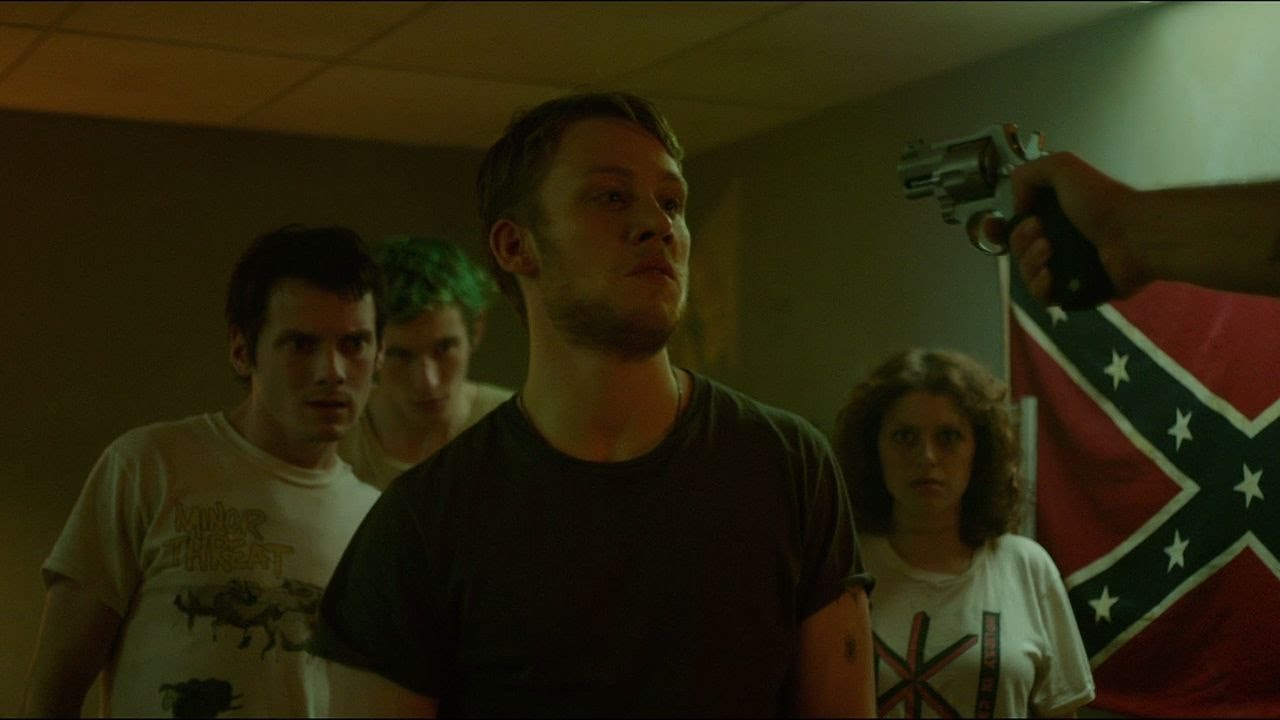
I said, “Look, let me go back and get this one film out of my system.” Because I know in three or four films’ time, I’m not going to be able to do this movie. Every year that I age is another year I am away from that personal experience of being in the punk hardcore scene, and being in bands, and having that archive that was still lingering in my brain. But as I get older and worry about my memory loss, I felt “I’ve got to do this right now”. It might disappoint some people, which it did.
I remember it premiered at Cannes and Vanity Fair said it was very entertaining movie and kind of did what it had to do but it was a profound disappointment or something like that. They wanted a lofty ensemble piece. They wanted me to go big and bad and get all the famous people I could and make an elegant adult movie. I was like, “Well, let me make a movie that’s for all the kids I knew growing up” – when we were 17 years old in the suburbs of DC in the hardcore scene and making movies in our free time – and do it for them.
We got our foot in the door, so we kind of snuck in the industry and opened the backdoor and let our friends in and made this crazy ass movie that no one else would. We kind of had this great opportunity and I had to take it. Also, I love genre film making and I wanted to go super hardcore with this one. I am getting softer as I grow older – I have these wonderful kids; I’m surrounded by love, joy. I wanted to make sure I could ratchet up the tension and the genre elements to 11 for this one so at least I have that under my belt. Before I did get soft or had to make some fucking animated movie for my kids [laughs], I’ve got to have this one done.
Obviously your background plays a huge part in the band realism. How’d you get your cast doing what they need to do to really convince as a band on screen?
Well, luckily Anton Yelchin and Alia Shawkat, they’re friends, and Imogen Poots was also their friend. They, of course, weren’t in a band but just having this sort of camaraderie on set was important. They knew what is was like to be in bands. I think Anton and Alia had played bass and guitar. I know Anton had a band called The Hammer Heads and they played cool venues but off hours like the Viper Room at Sunday at midnight, that kind of shit. So, Anton sort of served as the band leader. Joe Cole, who was cast just for his raw intensity and physicality, had never been near a drum set. I think Callum Turner – who played Tiger the lead singer – had never been in a band either or near music. So, there was a process of picking music, and then they performed three songs on camera. One of them was a Dead Kennedys cover and the other two are songs written by friends for my high school buddies’ bands.
That was pre-Internet so these songs, so near and dear to me that I’ve heard a thousand times, were never online or downloadable so they were still very esoteric and could be thought of as original songs. So, it was great to actually archive that, to see my friends’ music played on big screens throughout the world. We basically recorded these four songs. This was all during pre-production, so we kind of had these tracks laid down and we shot those instrumentals out to Joe and Callum who were in the UK. So, Joe started to take drum lessons and learned the four songs we had assigned him. It started pretty rough.
Callum got it a little easier because he was singing and could be a little bit off-tempo. He had this amazing charisma and energy that was very authentic and shocked me. He could be, right now, a punk singer. He was fantastic. Basically, because of visa issues and a very tight pre-production with no actual rehearsal time scheduled in, it was rough landing – Callum flew in at 11pm the night before we shot his first performance live. It was kind of insane.

Joe had been in town a couple of day and was learning a few songs. It was at the Mexican restaurant scene, one of the first scenes we shot on day one. So, it got a little rough. But then we had them all in town and we had the music. We had a band leader from Portland who went to the practice space. They actual practiced to the other songs in the movie and they eventually became a band. They would perform their own songs. Anton thought it was important for them to not only learn the songs they perform on screen but for them to go through the process of writing their own original song.
So, it was great. I’m friends with so many musicians. I was just a yeller in my band, just on the microphone. But I knew that this would end up being vetted and scrutinized by so many musicians that it really had to be authentic. And so we had a great first A.D. who had done a rock n roll film before and he helped build the strategy for how we’re going to perform these things live. Like, how do we use playback music but capture that live feel – that off-mic local delivery? It’s actually very technically involved. First, to get the band up to speed and their performances to be authentic. And then, we had to actually pretty much jettison all the live recordings we did as far as the audio component. A little bit seeped in but we had an amazing music editor who went through every frame of every track of the pre-recorded music and made it sound so very live. Callum was singing and if he went a little bit off mic the editor would take it down and add some reverb or whatever was needed. So, it was just really intense – but really paid off in the end. I watch it and I get really excited watching them perform Nazi Punks Fuck Off. It’s like you’re right there.

Hey, let’s talk violence. It’s a really major part of your film and it elicits gasps and gets a great reaction from the audience as it plays out. You depict violence as something that’s often very clumsy and may have unintended repercussions. Is that in your mind where you’re blocking the scenes that we see in ‘Green Room’?
It’s just all about authenticity, trying to get a believable environment, characters that are not just relatable but believable. That applies to stunt choreography and the prosthetics. It’s all plausible. I was relying so much on the perception of real people on screen to reinforce the tension. They’re not idiots, they’re not totally inept but they’re definitely out of their depth and flailing and trying to figure out what to do in this impossible situation. So, when they’re confronted with violence it had to be all of a sudden, when the movie turns and goes really dark and gets very brutal very fast. You just feel like the stakes are actually mortal. Like, this is real deal. They’re not just in a movie, they’re going to be killed.
I think to have that it’s all about how you cover it. How from the very technical detail of pumping blood and prosthetics and that hyper-real makeup to how the performers are acting. The whole movie turns on its head when there’s a certain attack from outside the room. Anton had some machete action going on there. We had to stretch his wrists, really work together and make sure that his physicality and the way he was dangling his wrists sold the entire gag. I get very very detail-oriented as far as how we’re going to sell gags and how we’re going to make it look real.
Jesus Christ, you sold that one so hard. It’s real rough!
It was rough in the edit room too. I used to do a lot of makeup effects when I was a kid. I did it through college. I had an internship at a place called Direct Effects in Brooklyn during film school. So, I’m very technically aware. But the key is to obsess over that and then let it go and then look at the actors. And so, if there’s a bunch of beefcake kids, like in horror movie style, just trying to be smart arse-y you don’t get it. No matter how amazing your makeup effects are, if you don’t have believable characterisation of all the actors it just doesn’t work. I do it intuitively. When I write, I like to get method and terrify myself. I don’t do it just to explore cool ways to die, I just do things that are terrifying to me. It isn’t always scary references in movies, in my films they’re from real life.
The knife in Emily’s head – the drag effect – was very important to me. It was cathartic for me. I was watching television, cable television, and I stumbled upon some prison documentary on a news channel and they showed this fucking knife attack in a prison courtyard. I said, “I don’t want to see this. I can never unsee this again.” I changed the channel but it never left me. It was just this horrifying thing. The little things that I’ve encountered unintentionally, that just haunt me, I put into the movies. It’s a way to get it out of my system and to infect the masses [chuckles].
I’ve got a phobia and it’s – how do I explain this? It’s to do with the idea that something really grotesque could happen to your body. But it’s not specific to what that is, just the idea of looking down and seeing the injury. And Anton’s arm moment really is definitely that – I fucking could not handle it when I watched that. I’m just terrified of being in – not that literal position – but that thought of “Oh my leg’s come off. Great.”
Oh yeah, well that was one of the most simple effects in the movie. It’s just a great prosthetic. It’s how Anton dangled his wrists that made everyone want to vomit in the room.
Stop it! As you ratchet up the tension and put your characters through hell, a couple of interesting senses of calm manifest in different ways. Patrick Stewart has got a sociopathic kind of calm to things whereas the dwindling survivors are what, suffering an adrenaline burnout? How would you describe the flattening of their emotions as the film proceeds? It seems like that’s a deliberate choice.
Yeah, for Patrick, I think, we used the term brutal pragmatism – where it’s not personal, it’s not sadistic, it’s self-preservation and mopping this up. And so, if he could undo the whole events of the night, he would. He was a reluctant participant but he had a single mission in mind and would do anything to that end. So, that was fun and we worked intentionally for him to go as quiet as possible. In fact, it was a record setting level of decibels. It was the quietest he ever performed on stage or screen [chuckles] in his life. He has since really enjoyed that process but it was not natural for him to speak in whispers like that. Very intimate. He’s got so much implied weight. He’s spoken of and he’s “on his way”. So, when he enters he can’t be too big. He’s got to just be calm and collected and sort of go against that. He, of course, has that star power.

The film has certain arcs going on, and as the tension ratchets up inside the green room – as the band members start to realize they are in mortal danger and they really have no way out – it gets hyperkinetic and just batshit crazy. It gets brutal and violent and sort of blunt force. At a certain point, a bit of an adrenaline slump happens. They’re trying to find a way out. They’re trying to use smart things that they think people should do. And if they’re encountering dead ends or dead friends– hey, I should have used that earlier, “dead ends or dead friends” [laughs].
Anyways, they lose hope. And so, I think just this exhaustion and hopelessness overtakes them. And, I think, through that we couldn’t keep going. They couldn’t keep crying and crying and crying and heaving… they were out of body fluids! I think that helped lead them to a way out.





